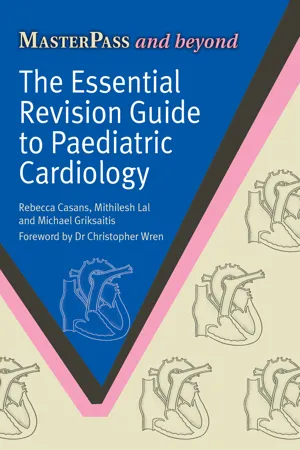
The Essential Revision Guide to Paediatric Cardiology
- 252 pages
- English
- ePUB (mobile friendly)
- Available on iOS & Android
The Essential Revision Guide to Paediatric Cardiology
About This Book
A unique reference book covering the relevant basic sciences of cardiac anatomy, physiology and pharmacology through to the initial clinical assessment and investigation. It covers the core curricula for paediatricians in training at all levels including the MRCPCH and DCH examinations. This book is relevant to paediatricians in training, general practitioners, emergency department staff and specialist nurses. General staff working in specialist regional cardiac centres and healthcare professionals involved in the care of children and young people will also find this essential resource extremely useful. 'The aim of this handbook is to provide a rapid and reliable reference to congenital and acquired cardiac problems. It is very well organised. provides a more detailed discussion of cardiac physiology and pathophysiology and a comprehensive guide to ECG interpretation. It should be of particular interest to paediatricians in training, including those studying for higher professional examinations, but it also provides a valuable source of reference for paediatricians already in practice.' From the Foreword by Dr Christopher Wren
Frequently asked questions
Information
CHAPTER 1

Royal College of Paediatrics and Child Health examination structure
RCPCH: EXAMINATION STRUCTURE

THE INDIVIDUAL PARTS OF MRCPCH
Part 1A
Part 1B
- ➤ Paper 1a focuses on the areas of child health that are relevant to those who will be working with children in their medical careers, not just those entering mainstream hospital-based paediatrics. The areas to be tested will be those conditions likely to be seen in 6 to 12 months of hospital, community or primary care practice. This paper also serves as the written component of the Diploma in Child Health examination.
- ➤ Paper 1b focuses on the more complex paediatric problem-solving skills not tested in Paper 1a, and on the scientific knowledge underpinning paediatrics.
THE NUMBER OF EXAMINATION QUESTIONS
- ➤ 2 extended matching questions (EMQ) worth 9 marks each (3 per item)
- ➤ 15 multiple true-false questions worth 5 marks each (1 per item)
- ➤ 48 best of five questions worth 4 marks each
QUESTION TYPES
Multiple true-false questions
- ➤ ‘The following statements about X condition are true:’
- ➤ ‘X is a complication of’.
- ➤ ‘Characteristic features of X condition include’
Best of Five questions
- ➤ ‘What is the most likely diagnosis?’
- ➤ ‘Which investigation is most likely to lead to a diagnosis?’
- ➤ ‘What is the best next step?’
- ➤ ‘What is the best advice to give to parents?’
- ➤ ‘What is the most likely pathogenesis of this condition?’
- ➤ ‘What is the most common cause of this?’
Extended matching questions
- ➤ ‘Choose the most likely diagnosis from the following:’
- ➤ ‘Choose the best treatment for each of these children:’
- ➤ ‘Choose the organism which matches most closely each of the following case scenarios:’
PART 2 WRITTEN
Table of contents
- Cover
- Title Page
- Copyright Page
- Table of Contents
- Foreword
- Preface
- Acknowledgements
- Accreditations
- Dedication
- 1 Royal College of Paediatrics and Child Health examination structure
- 2 Basic cardiac anatomy, physiology and pharmacology
- 3 Examination of the cardiovascular system
- 4 Interpretation of the paediatric ECG
- 5 Investigations for suspected cardiac disorders
- 6 A–Z of paediatric cardiac disorders and procedures
- 7 Hot topics: a quick reference guide
- Appendix: reference tables, normal values
- Glossary
- Index